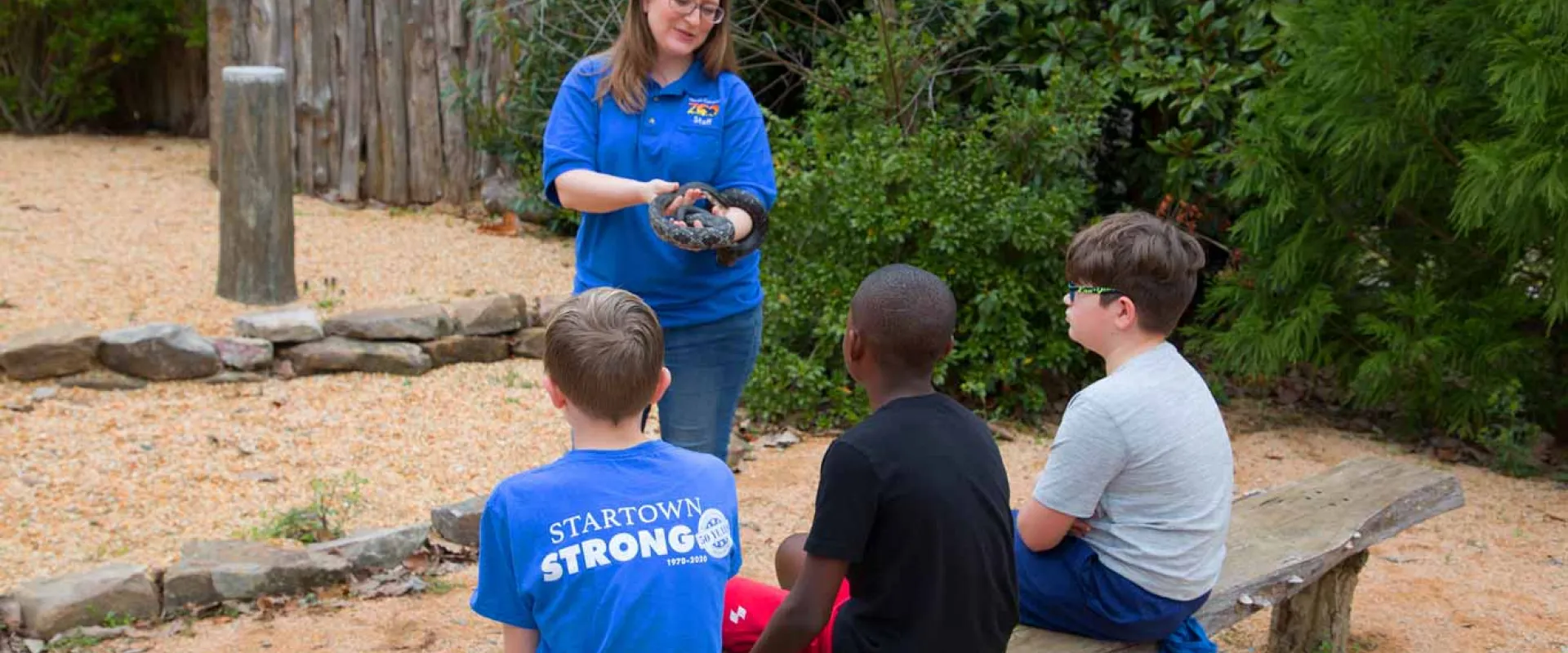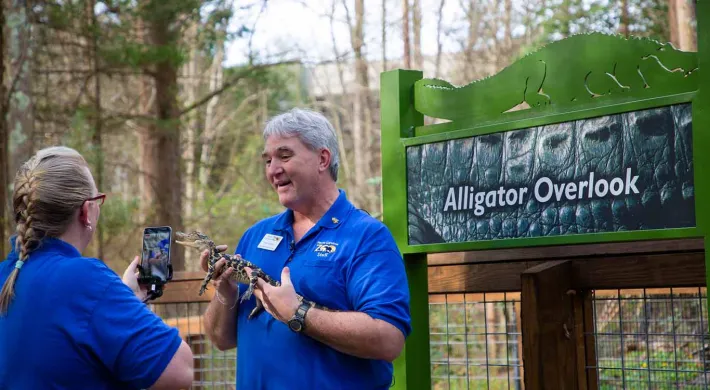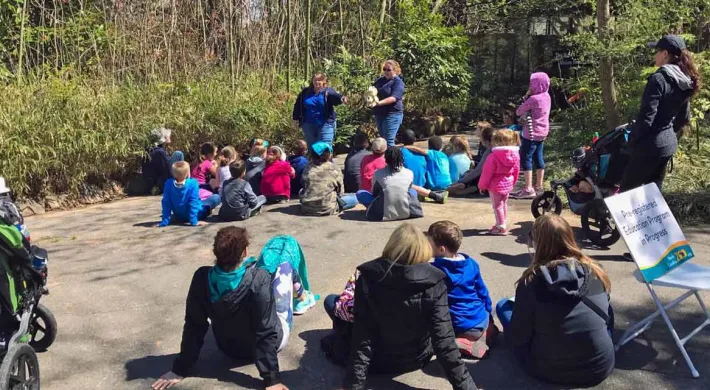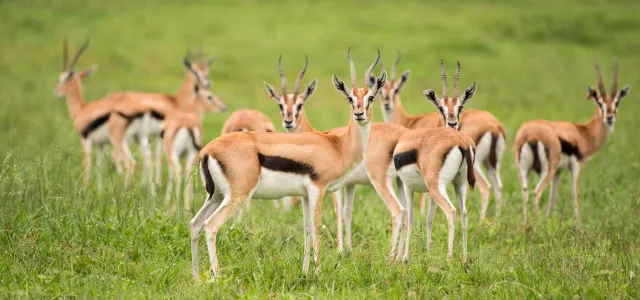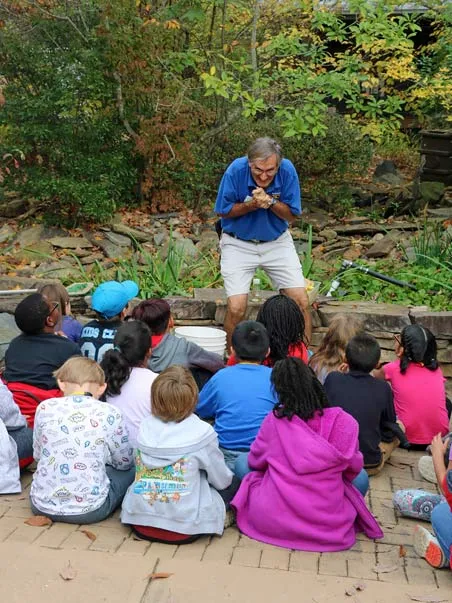
On-Site Programs
Looking for a wild experience for your students? The North Carolina Zoo offers a variety of engaging educational programs for school groups visiting the Zoo. These programs enrich student learning about animals, the need for healthy habitats, and the actions they can take to help protect and preserve Earth’s natural resources. We offer programs for both classes (30 or less people) and assembly size programs (up to 200 people).
To Schedule a Program
There is a minimum of four weeks notice for any program and full payment is due at the time of checkout.
- Choose a date here to visit the zoo with an educational program add-on!
- If the desired date is available, continue with the online checkout process until you receive a confirmation screen. If the desired date is listed as sold out or unavailable, please email schoolprograms@nczoo.org as we do have some availability not listed on our ticketing site and may be able to accommodate your group.
- Call reservations at 336-879-7700 to inform them of the date you will be bringing a school group, number of students, and ask any logistical questions about the zoo.
- You will receive an email at the email contact provided on our ticketing site. Please respond to any questions we may have and we will do the same.
- As a final step you will receive a confirmation document showing the location, time, and date of the educational program you purchased. Review this document and respond with a final confirmation. You're all set to visit the zoo and receive an educational program!
Explore our Program Offerings
K-8th Grade
| Program Title | Suggested Grades | Descriptions | Standards | Location |
| Animal Wrappers | K-1st | From fur to feathers and scales to skin, explore how animals’ unique "wrappers" help them survive in Arctic chills, desert heat, and forest ponds! Designed for K–1st grade learners, this interactive program features hands-on biofacts, and a fun habitat-matching game to inspire young conservationists to help wildlife in their own backyards. | PS.K.1.1 | LS.K.1.2 | LS.1.1.1 | LS.1.1.2 | At the Zoo or Zoo to You |
| Eggs to Legs | 1st-2nd | Wiggle, hop, and crawl through the incredible life cycles of frogs, insects, and turtles! In this hands-on program designed for 1st–2nd grade learners, students will explore how animals grow, change, and overcome challenges at every stage of life. Through interactive movement, storytelling, and conservation connections, students discover how the North Carolina Zoo gives young animals a HeadStart—and how they can help protect wildlife too! | ESS.13.1 | ESS1.3.2 | LS2.1.1 | LS.2.1.2 | LS.2.2.1 | At the Zoo or Zoo to You |
| Plant Partners | 1st-3rd | From roots to blooms, plants can’t thrive alone! This engaging program, uncover how animals, soil, and the environment all play a role in helping plants grow. Students explore plant life cycles and get hands-on with real biofacts. Along the way, they’ll learn how the plants thrive at the North Carolina Zoo and Botanacle Garden and how they can help plants thrive too! | LS1.1.1.1 | LS.1.1.2 | ESS.1.3.2 | LS.3.2.1 | LS.3.2.2 | LS.3.3.1 | LS.3.3.2 | At the Zoo or Zoo to You |
| Amazing Adaptations | 4th-5th | Dive into the world of amazing adaptations! Explore how animals survive using external, internal, and behavioral adaptations! With real animal examples and biofacts, learn how the NC Zoo cares for the animals at the Zoo and in the wild and what happens when environments change too fast. | LS.4.1.1 | LS.4.1.2 | LS.4.1.3 | ESS.4.3.1 | ESS.4.3.2 | ESS.4.3.3 | LS.5.2.1 | LS.5.3.2 | LS.6.2 | LS.6.2.2 | At the Zoo or Zoo to You |
| Carolina's Coolest | 4th-6th | From sea turtles to salamanders, North Carolina is home to amazing animals, and the NC Zoo is working to protect them. In this engaging program ,students explore wildlife across the state’s mountains, piedmont, and coast lines. Discover how people can help animals thrive even in their own backyards! | ESS.4.3.1 | ESS.4.3.2 | ESS.4.3.3 | LS.5.2.1 | LS.5.2.3 | LS.5.2.2 | ESS.6.3.2 | At the Zoo or Zoo to You |
| Wild Genetics | 7th-8th | Dive into the fascinating world of animal genetics and discover how the North Carolina Zoo uses science to save species like red wolves and rhinos from extinction. Explore real-life challenges in managing breeding programs to conserve species, while applying classroom genetics to hands-on problem-solving. Get ready to think like a conservation scientist and help protect wildlife through genetics! | LS.7.2.1 | LS.7.2.2 | LS.8.3.1 | LS.8.3.2 | At the Zoo or Zoo to You |
| Animal Behavior Detectives | 5th-6th, 8th | Explore how studying animal behavior helps the North Carolina Zoo promote health, happiness, and conservation for all its creatures. From instincts to learned behaviors, discover what animals need to thrive in their environments. Through immersive videos and hands-on activities, you’ll see how understanding behavior supports wildlife care—and how your choices can make a difference for animals and their habitats. | LS.5.3.1 | LS.5.3.2 | ESS.6.3.2 | LS.8.2.1 | LS.8.2.2 | At the Zoo |
| Organism Organization | 5th, 7th-8th | What do a polar bear, a snake, and you have in common? A lot more than you think! In this program, we’ll explore how all living organisms are built and maintained through organized structures like cells, tissues, organs, and systems. Students will compare body systems, and discover how Zoo veterinarians apply this knowledge to care for wildlife. Plus, we’ll spotlight some of the animals at the North Carolina Zoo and learn how understanding health and structure helps protect animals both in human care and in the wild. | LS.5.1.1 | LS.5.1.2 | LS.7.1.1 | LS.7.1.2 | LS.7.1.3 | LS.7.1.4 | LS.8.1.1 | LS.8.3.1 | At the Zoo or Zoo to You |
| Zoo Jobs | 4th grade and up | Ever wonder what it’s like to work at a zoo? In this program at the North Carolina Zoo, students will dive into the wild world of zoo careers! From animal care and veterinary science to habitat design, conservation biology, and more, students will leave with a better understanding of the many jobs needed to make the North Carolina Zoo an educational experience for one million guests each year! After the program, students who decide to explore the zoo can take part in a self-guided, interactive activity that highlights real Zoo Jobs in action! | At the Zoo |
9th-12th Grade
| All our high school programs are upon request and can be customized for any group, topic, or standard. We highly encourage our programs to also include an extension activity or project, whether facilitated by our educators or by the classroom teacher! Here are some examples of programs we have done in the past: | |
| 45 minute - 1 hour Educational Programs | A zoology class had an increased interest in symbiosis in animals. We provided an educational program with a live animal ambassador, allowing students to ask more in depth questions about specific species. |
| An Earth Environmental class was covering conservation work and reached out to see what materials we could provide since the North Carolina Zoo is so active in conservation work. We provided an educational program about our work and Red Wolf SAFE, and led students in a short debate on if coyotes are a nuisance species or an invasive species. | |
| A nutrition class was interested in how we incorporate nutrition into our animal care. We were able to have students meet a live animal ambassador and discuss their unique dietary care. | |
| A horticulture class was able to tour the compost area and discuss the importance of composting throughout the zoo. | |
| A physics class discussed the physiology of animals that allowed them to move in the most efficient manner. We had a live animal ambassador present for students to make observations about and relate back to physics terms. | |
| Longer educational experiences | An afterschool group of high schoolers had an interest in dinosaurs. We provided an educational program about the archaeopteryx, and led students in a short student led debate: bird or dinosaur? We then led a community science birding hike for the students as an extension. (~2hr) |
| A herpetology club wanted a hands on herpetology experience. We provided a species spotlight program with a live animal ambassador, a community science salamander hike aiding in research at the Zoo, and a project to create a toad abode for the club to place outside their classroom. (~4-10hr) | |
| An Earth Environmental class participated in water quality community science through chemical testing, macroinvertebrate identification, and a short species spotlight for a bioindicator live animal ambassador. (~4-10hr) | |
Virtual Programs (K-12)
| Program Title | Suggested Grades | Descriptions | Standards |
| Amazing Adaptations | 4th-6th | Animals are amazing at adapting to their habitats and environments. Amazing Adaptations lets us look at the specialty adaptations some animals possess to survive and thrive in different habitats and environments. | LS.4.1 | LS.4.1.2 | LS.4.1.3 | LS.5.2 | LS.5.2.3 | LS.6.2 | LS.6.2.2 |
| Animal Wrappers | K-2nd | Not all animals look and feel the same. Why does a black bear pelt feel different than a harbor seal pelt? Together we look at the different “wrappers” of animals and use audience observations to explain adaptations. | PS.K.1.1 | LS.K.1.1 | LS.1.1.1 |
| Carolina's Coolest | 4th-6th | When you think of the zoo, you likely think of Elephants and Giraffes and Rhinos. While we do have amazing African animals at the North Carolina Zoo, we also have animals that live here in North Carolina that you may have never seen! Let us bring the fun to you, to talk about birds, reptiles, amphibians, and animals that can all be found right here in your backyard. | ESS.4.3.2 | LS.5.2.2 | LS.6.2.2 |
| Chasing Chytrid | 9th-12th | Chytrid is a fungus that has been recognized as the most deadly pathogen globally. Learn the ins and outs of such a fatal fungus and learn how you can support our amphibians. | Standards available upon request (can overlap with multiple high school courses) |
| Feet, Paws, and Claws | K-3rd | The different feet, paws, and claws of different animals serve a purpose, but why do they all look so different? Discover the differences between our toes. | PS.K.1.1 | LS.K.1.1 | LS.1.1.1 |
| From Eggs to Legs | 1st-3rd | Most elementary students can explain frogs come from eggs, but there are so many other creatures that start out as eggs and end up with legs! Join us in exploring these other creatures while reviewing an elementary classic: the frog lifecycle. | LS.1.1 | LS.2.1 | LS.2.1.2 |
| Gentle Giants | K-2nd | Join us for a showcase of our largest animals at the zoo! This will be a pre-recorded experience with a live educator facilitating and answering questions. | PS.K.1 | LS.K.1.2 | LS.1.1 | LS.1.1.1 | LS.2.2.1 |
| Giving a Frog Leg Up: Carolina Gopher Frogs | 6th-8th | The North Carolina Zoo's work with Carolina Gopher Frogs is an incredible story of successful conservation in our area. Join us as we tell the story, and meet an ambassador for this endangered species. | LS.6.2.2 | LS.7.1 | LS.8.2 | LS.8.2 | ESS.8.4 |
| Snakes: Friend or Foe | 6th-8th | Snakes are one of the most feared animal types in the world, but do we have something to fear? Learn about unique snake adaptations, interesting facts, and the importance of snakes in our world and then decide…should snakes really be our friend or are they truly a foe? | LS.7.1 | LS.8.2 |
| Sustainability: More than Reduce, Reuse, Recycle | 9th-12th | A holistic view of sustainability integrating some of the sustainable development goals and how high schoolers can go beyond merely reduce, reuse, recycle, and instead further their sustainability impact. | Standards available upon request (can overlap with multiple high school courses) |
Frequently Asked Questions
What price will the program be?
Prices start at $75 for a class sized program, $100 for less than 100 students, and $125 for 100-200 students.
Are there discounts available?
Yes! Please contact schoolprograms@nczoo.org to see if you qualify.
Do I have to purchase the program online?
Unfortunately, we are not able to reserve dates for school groups and the educational programs are first come first served. You can however reach out to schoolprograms@nczoo.org to see if a date has additional availability if it says sold out or unavailable, as we do have some additional availability not listed on the eTix site.
Can you sign a contract with my county/school/group?
Unfortunately, we are not able to sign any contracts or agreements. Please reach out to schoolprograms@nczoo.org to determine if there are other options for you.
For further information contact the North Carolina Zoo's School Programs Office via email.
